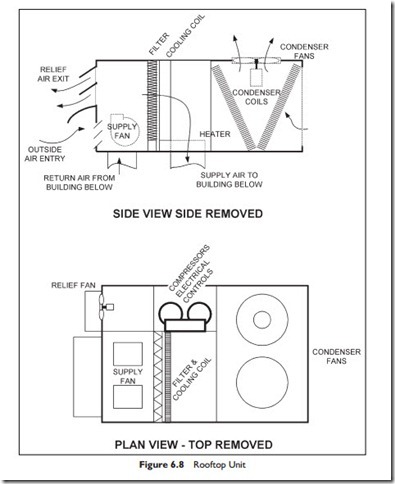Rooftop Units
A typical rooftop system is diagrammed in Figure 6.8. The return air is drawn up into the base of the unit and the supply air is blown vertically down from the bottom of the unit into the space below. As an alternative, the ducts can project from the end of the unit to run across the roof before entering the building.
The major advantages of these units are
No working parts in the occupied space—so maintenance can be carried out without disrupting activities within the building and maintenance can be carried out without access to the building when the building is closed.
No space is built for the unit—which saves construction costs.
No delay for detailed manufacturer design work—because the unit is pre-designed.
No wide access during construction—because the unit is outside the building envelope, the contractor does not have to keep an access available for the unit to be moved in during construction.
There are, of course, disadvantages.
Critical units must be maintained regardless of the weather conditions—That means that maintenance could be required in heavy rain, snow, or high
winds. This potential problem can be managed by having a maintenance access space located along one side of the unit.
Choice of performance is limited to the available set of components—This is often not enough of a problem to make the unit unacceptable, and can frequently be overcome by using a split unit, which we will be discussing in the next section.
Choosing a rooftop unit is fairly straightforward. One needs to know both inside and outside design-temperatures, required airflow, in cfm, mixed-air temperature, and the required sensible and latent cooling-loads.
The mixed-air temperature can be calculated based on the return-air temperature, the-outside air temperature and the required proportion of outside air. Referring back to the example, shown in Figure 6.7 above, the room temperature, which we will consider to be return temperature, was 75°F, and the outside ambient temperature was 95°F. If 20% outside air is required, then the mixed temperature can be estimated by proportion
The calculation of airflow is covered in detail in ASHRAE Course
Fundamentals for Air System Design1.
It is important that the airflow is correctly calculated and that the unit is setup and balanced to provide the correct airflow. With direct expansion refrigeration circuits, too little airflow over the evaporator can cause problems:
Imagine that the airflow is much slower than design. The slow speed past the coil will allow the air to cool further, and if the coil is below freezing, for ice to start to form. The slow flow will also reduce the heat being absorbed into the evaporator, so the compressor’s suction will be drawing with little refrigerant vapor coming in. As a result, the pressure in the evaporator will fall, causing the evaporator temperature to fall, which again, will tend to cause freezing. Once ice formation starts, the ice starts to block the flow, causing even slower airflow until the coil is encased in ice. Ice formation on the evaporator can also be caused by too little refrigerant in the system – a common result of a slow refrigerant leak.
As noted in the previous discussion of loads versus capacity, air-handling units come in discrete sizes, so a perfect match of unit and calculated loads does not happen. From the example in Figure 6.7, for our loads of 200,000 Btu/h sensible load and 20,000 Btu/h latent load, let us assume the closest unit has a performance of 240,000 Btu/h sensible and 60,000 Btu/h latent capacity. This looks excessively oversized, but two factors have to be considered: First the unit’s sensible capacity does not take into account the heat from the supply fans in the unit. Suppose the fan load was 6 kW (3,412 Btu/hr = 1 kW) then the fan-heat added to the cool air would be:
The 60,000 Btu/h moisture removal, when compared to the required 20,000 Btu/h, is a common issue in dry climates. The coil removes more moisture than required. There are two results. First, more energy is used than required to maintain the design conditions. Second, the real conditions will be drier than the design condition.
The converse problem, of too little moisture removal, occurs in hot moist climates, particularly where higher proportions of outside air are required. In this case, and others, it may not be possible to find a package rooftop-unit for the duty and it may be advantageous, or necessary, to take special measures to remove moisture. Some of these are discussed in Chapter 13.
Heating choices are generally less of an issue, but the designer still has to be aware of potential problems. As noted earlier, electrical heaters are normally available with stepped capacity, but gas heaters are often on-off or high-low-off. If the unit runs continuously as the gas-heater cycle, the air supply will fluctuate in temperature and sometimes blow warm, and sometimes blow cold. Take care to ensure that the occupants do not have an intermittent cold draft blowing on them.
Having considered the single-zone air handler, with particular emphasis on the rooftop unit, let us now consider another popular single-zone system, the split system.

